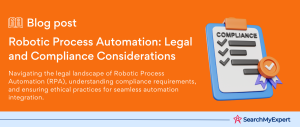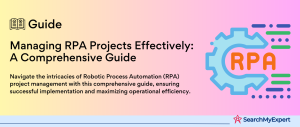Robotic Process Automation (RPA): A Modern Solution to Streamline Business Processes
Understanding Robotic Process Automation (RPA)
Robotic Process Automation (RPA) represents a transformative technology that automates routine and repetitive tasks traditionally performed by human workers. At its core, RPA uses software robots, or ‘bots’, to mimic human actions within digital systems. These bots interact with various applications and software in the same way a human would but with greater speed, accuracy, and consistency. The primary purpose of RPA is to streamline workflow, enhance efficiency, and reduce operational costs. By automating tasks such as data entry, report generation, and even complex analytical jobs, RPA frees up human employees to focus on more strategic, creative, and customer-focused initiatives.
The Role of Tools and Technologies in RPA
RPA Development Platforms
RPA platforms are the foundational tools that enable the creation and management of software robots. These platforms provide user-friendly interfaces for designing automation workflows, often without requiring extensive programming knowledge. Leading RPA platforms like UiPath, Blue Prism, and Automation Anywhere offer features such as drag-and-drop functionality, process recording, and script generation, making it easier to build and deploy bots.
Integration Capabilities
An integral part of RPA tools is their ability to integrate with a wide range of enterprise systems, from legacy software to modern cloud-based applications. This integration is facilitated through APIs (Application Programming Interfaces) or screen scraping methods, ensuring that RPA bots can work across different technological environments. This capability is crucial for automating end-to-end business processes that involve multiple systems.
Cognitive and AI Components
Advanced RPA solutions are increasingly incorporating cognitive technologies like machine learning, natural language processing, and artificial intelligence. These components enable bots to handle unstructured data, make decisions based on historical data patterns, and learn from previous actions. For instance, AI-enhanced RPA can read and interpret emails, extract relevant information, and perform actions based on the content, significantly expanding the scope of automation.
Analytics and Reporting Tools
Monitoring and analyzing the performance of RPA bots is vital for ensuring efficiency and identifying areas for improvement. Modern RPA tools come equipped with analytics dashboards that provide insights into bot performance, error rates, and process completion times. These analytics help organizations to optimize their automation strategies and achieve better ROI.
Security and Compliance Features
As RPA bots handle sensitive data and critical business processes, security is a paramount concern. RPA tools are designed with robust security features like role-based access control, audit logs, and encryption to safeguard data integrity and compliance with regulatory standards. This ensures that automated processes adhere to organizational policies and industry regulations.
Core RPA Capabilities: Enhancing Business Efficiency through Automation
Capture and Record: The Foundation of RPA Bot Creation
Process Recording and Analysis
RPA tools employ sophisticated techniques to capture and record human interactions with computer applications. This is often achieved through a process known as process recording, where the RPA software observes and logs the actions performed by a user. For instance, when a user navigates through an application, inputs data, or generates reports, the RPA tool records each click, keystroke, and data entry.
Script Generation and Customization
Once the user’s actions are captured, RPA tools generate automation scripts or workflows that replicate these actions. Users can further refine and customize these scripts to meet specific business requirements. This ability to record and translate human actions into automated workflows is a cornerstone of RPA technology, allowing for rapid development and deployment of bots.
Data Manipulation and Extraction: Automating Complex Data Tasks
Data Extraction and Interpretation
RPA bots excel at extracting data from various sources, including structured databases, spreadsheets, and even unstructured sources like emails and PDF documents. They use pre-defined rules or AI capabilities to identify and extract relevant data, enabling automated processing of vast amounts of information with high accuracy.
Transformation and Manipulation
Beyond extraction, RPA tools can transform and manipulate data to suit different purposes. This includes formatting changes, calculations, data merging, or splitting, and ensuring that the data is in the right format and structure for further processing or analysis.
Integration and Scheduling: Streamlining Operations Across Platforms
Cross-Application Interaction
RPA bots are designed to interact seamlessly with various applications and systems, whether it’s legacy software, ERP systems, or cloud-based applications. They can log into applications, extract data, input information, and execute transactions across different platforms without human intervention.
Workflow Scheduling
Scheduling is a critical feature of RPA, allowing organizations to automate tasks at specific times or intervals. For example, a bot can be scheduled to generate daily sales reports every morning or to perform monthly financial reconciliations. This scheduling capability ensures that repetitive tasks are completed consistently and without delays.
Monitoring and Reporting: Ensuring Efficiency and Compliance
Real-time Monitoring
RPA tools provide real-time monitoring capabilities, allowing organizations to track the performance of their bots. This includes monitoring the number of tasks completed, identifying bottlenecks, and detecting errors in real-time. This oversight is crucial for maintaining the efficiency and reliability of RPA workflows.
Analytics and Reporting
Advanced analytics are integral to RPA tools, offering insights into bot performance and process efficiency. Reporting features enable the generation of detailed reports on various metrics like process completion times, error rates, and cost savings. This data is invaluable for assessing the impact of RPA and guiding strategic decisions for process improvement.
Key RPA Tools and Technologies: Driving Automation Forward
Software Robots (RPA Bots): Leading Platforms and Features
UiPath
UiPath stands as a leader in the RPA market, known for its user-friendly interface and versatile automation capabilities. It offers a range of features including drag-and-drop workflow design, process recording, and a robust library of pre-built activities. UiPath also excels in scalability, enabling businesses to deploy a large number of bots with ease.
Automation Anywhere
Automation Anywhere is another major player, offering a cloud-native platform with strong capabilities in scriptless automation, cognitive automation, and analytics. Its standout feature is the IQ Bot, which employs AI to process unstructured data, making it a powerful tool for complex data-driven tasks.
Blue Prism
Blue Prism is recognized for its enterprise-grade RPA solutions, focusing on security and scalability. It provides a model-driven approach to automation, allowing for the creation of sophisticated and highly efficient bots. Blue Prism’s integration with AI and machine learning technologies further enhances its capabilities.
Artificial Intelligence (AI) Integration: Enhancing RPA with AI Technologies
AI technologies like machine learning and natural language processing (NLP) are increasingly being integrated into RPA platforms, augmenting their capabilities.
Machine Learning
Machine Learning enables RPA bots to learn from data patterns and improve over time. This is particularly useful in processes that involve predictive analytics or decision-making based on historical data.
Natural Language Processing
NLP allows bots to understand and interpret human language, enabling them to process unstructured data from emails, documents, and chat conversations. This integration significantly expands the scope of RPA in customer service and other communication-heavy areas.
Cloud-based RPA: Advantages for Modern Businesses
Cloud-based RPA solutions offer several advantages, including scalability, accessibility, and enhanced collaboration.
Scalability and Flexibility
Cloud-based RPA allows organizations to scale their automation efforts up or down based on their current needs, without the constraints of on-premise hardware.
Accessibility and Collaboration
Being cloud-based, these RPA solutions enable remote access, allowing teams to collaborate and manage bots from anywhere. This is especially relevant in today’s increasingly remote and distributed work environments.
Security and Compliance Considerations in RPA Deployment
Data Security and Privacy
When deploying RPA, data security is a critical consideration. RPA tools must ensure data encryption, secure access controls, and audit trails to protect sensitive information.
Compliance Requirements
Different industries have varied compliance requirements. RPA solutions must
be adaptable to comply with industry-specific regulations, such as GDPR for data privacy or HIPAA for healthcare. These platforms often include features to monitor and log bot activities, ensuring that automated processes adhere to legal and regulatory standards.
Selecting the Right RPA Tools: A Guide to Making Informed Decisions
Factors to Consider When Choosing RPA Tools
Process Complexity
- Understanding Business Processes: Assess the complexity of the processes you wish to automate. Simple, rule-based tasks might require basic RPA solutions, while complex processes may need advanced AI integration.
- Customization Needs: Consider whether the RPA tool can be customized to handle specific process requirements, especially for unique or industry-specific tasks.
Budget Considerations
- Cost-Benefit Analysis:
Evaluate the cost of RPA tools against the potential ROI they offer. This includes considering licensing fees, implementation costs, and ongoing maintenance expenses. - Scalability vs. Investment:
Align your choice with your budget, keeping in mind the scalability of the tool for future expansion.
Existing IT Infrastructure
- Integration Capability:
Ensure the chosen RPA tool can seamlessly integrate with your existing IT infrastructure, including legacy systems, ERP software, and cloud services. - IT Support and Resources: Consider the level of IT support available in your organization for deploying and maintaining RPA solutions.
Matching Capabilities to Needs: Assessing Automation Requirements
Identifying Automation Objectives
- Business Goals:
Understand your business goals – whether it’s cost reduction, accuracy improvement, speed, or scalability. - Task Analysis: Identify specific tasks suitable for automation, considering factors like repetitiveness, volume, and rule-based nature.
Evaluating RPA Functionalities
- Feature Set:
Compare the features of various RPA tools – such as process recording, AI and ML capabilities, data processing, and reporting tools. - Usability: Consider the ease of use, especially if the tool will be used by non-technical staff.
Vendor Selection and Partnerships: Navigating the RPA Marketplace
Comprehensive Vendor Evaluation
- Reputation and Reliability:
Research the vendor’s market presence, customer reviews, and case studies to gauge reliability and effectiveness. - Support and Training:
Look for vendors that offer robust support and training resources to facilitate smooth implementation and adoption.
Considering Integration and Innovation
- Integration Options:
Investigate the compatibility of the RPA tool with other technologies and platforms used in your organization. - Future-Proofing:
Choose vendors that demonstrate a commitment to innovation, ensuring that the tool remains relevant as technology evolves.
Implementing and Scaling RPA: Strategies for Success
Proof of Concept (POC): Validating RPA Solutions
Importance of POC in RPA Implementation
- Risk Mitigation:
A Proof of Concept serves as a preliminary test, allowing organizations to evaluate the effectiveness of RPA solutions in a controlled environment before full-scale implementation. - Demonstrating Value:
POCs help in demonstrating the potential ROI and benefits of RPA, making it easier to secure buy-in from stakeholders.
Steps in Conducting a POC
- Select Appropriate Processes:
Choose processes that are representative of broader operations and stand to benefit significantly from automation. - Measure Performance: Assess the performance of the RPA solution in terms of efficiency gains, error reduction, and time savings.
Change Management and User Adoption: Ensuring Smooth Transition
Cultivating a Culture of Innovation
- Communication and Awareness: Educate employees about the benefits and changes brought about by RPA, addressing any concerns and misconceptions.
- Inclusivity in Decision Making: Involve staff in the RPA implementation process, encouraging feedback and suggestions.
Training and Skill Development
- Developing New Skills: Provide training programs to upskill employees, enabling them to work alongside RPA bots and focus on higher-value tasks.
- Continuous Learning:
Establish ongoing learning opportunities to keep staff updated with the latest RPA developments and best practices.
Scaling RPA Initiatives: From Pilot to Full-Scale Automation
Building on Successes of Pilot Projects
- Analyzing Pilot Outcomes: Use the insights and learnings from pilot projects to refine strategies for broader implementation.
- Showcasing Success Stories: Share successful pilot results across the organization to build confidence and support for scaling RPA.
Strategic Expansion of RPA
- Prioritizing Processes for Automation:
Identify and prioritize additional processes for RPA implementation based on their impact and feasibility. - Infrastructure and Governance:
Ensure that the necessary IT infrastructure and governance models are in place to support the expansion of RPA.
Continuous Improvement and Adaptation
- Feedback Loops: Establish mechanisms for continuous feedback to monitor and improve the performance of RPA solutions.
- Adapting to Changing Needs:
Stay adaptable to evolving business requirements and technological advancements, continuously optimizing RPA initiatives.
Case Studies and Applications: Real-World Success Stories of RPA
Successful RPA Implementations Across Industries
Banking and Finance
Case Study: A Major Bank’s Loan Processing
- Challenge:
The bank faced challenges in processing a high volume of loan applications efficiently. - RPA Implementation:
Deployed RPA bots to automate data extraction, validation, and entry for loan processing. - Results:
Achieved a 70% reduction in processing time and significantly decreased error rates.
Healthcare
Case Study: Hospital Administration Automation
- Challenge: A large hospital struggled with managing patient records and appointment scheduling efficiently.
- RPA Implementation: Introduced RPA to automate patient data management and appointment scheduling processes.
- Results: Improved patient record accuracy and reduced administrative workload by 50%.
Retail
Case Study: Inventory Management in a Retail Chain
- Challenge: The retailer needed a more efficient system for inventory tracking and order management.
- RPA Implementation: Implemented RPA bots to handle inventory updates, order processing, and supply chain management.
- Results: Enhanced inventory accuracy, faster order processing, and a 30% reduction in supply chain costs.
Quantifying the Impact of RPA: Metrics and Data
Cost Savings
- Example: In the banking sector, RPA implementation led to an estimated cost reduction of around 40% in operational processes.
- Data Insight: Reduced labor costs and increased efficiency are primary drivers of cost savings.
Time Efficiency
- Example:
Healthcare providers using RPA reported a 60% reduction in the time required for patient data processing. - Data Insight:
RPA bots operate 24/7 without breaks, significantly speeding up task completion.
Improved Accuracy
- Example: Retail chains experienced a 90% decrease in errors in inventory management after RPA deployment.
- Data Insight:
RPA eliminates human errors in repetitive tasks, enhancing data accuracy and reliability.
The Future of RPA: Trends, Innovations, and Its Role in the Digital Workforce
Emerging Trends and Innovations in RPA Technology
Cognitive Automation
- Advancements:
Cognitive automation combines RPA with AI technologies, enabling bots to handle more complex, judgment-based tasks. - Impact: This evolution allows for the processing of unstructured data, such as interpreting text and images, and making context-based decisions.
Hyperautomation
- Definition: Hyperautomation refers to the end-to-end automation of entire business processes, integrating RPA with advanced technologies like AI, machine learning, and process mining.
- Future Outlook: It’s poised to enable more comprehensive automation solutions, moving beyond individual tasks to broader organizational workflows.
Integration with IoT
- Convergence with IoT:
The integration of RPA with the Internet of Things (IoT) opens new possibilities for automating physical tasks and data collection in real time. - Applications:
This integration is particularly significant in industries like manufacturing and logistics, where IoT devices can trigger RPA bots for various tasks.
The Role of RPA in the Digital Workforce
Augmenting Human Capabilities
- Collaboration with Humans:
RPA is increasingly seen as a tool to augment human capabilities rather than replace them, taking over mundane tasks and freeing up humans for higher-value work. - Enhancing Skills:
As RPA handles routine aspects, employees can focus on areas like strategic planning, creative problem-solving, and customer interaction.
Shaping the Future of Work
- Changing Job Roles: The rise of RPA is leading to a transformation in job roles, with an increasing demand for skills in bot management, process design, and data analysis.
- Creating New Opportunities:
Far from eliminating jobs, RPA is creating new career paths and opportunities in the realm of digital technology and automation management.
Conclusion
Robotic Process Automation (RPA) stands at the forefront of technological advancements in business automation. This comprehensive guide has explored the various facets of RPA, from its basic definition, core capabilities, and key tools, to practical implementation strategies and impactful real-world applications. We delved into the nuances of selecting the right RPA tools, aligning them with business objectives, and effectively scaling automation initiatives. Through diverse case studies, we illustrated the tangible benefits of RPA across industries, highlighting significant improvements in efficiency, cost reduction, and accuracy.
Experience next-level automation with Robotic Process Automation Service Companies.
Table of Contents
Toggle






